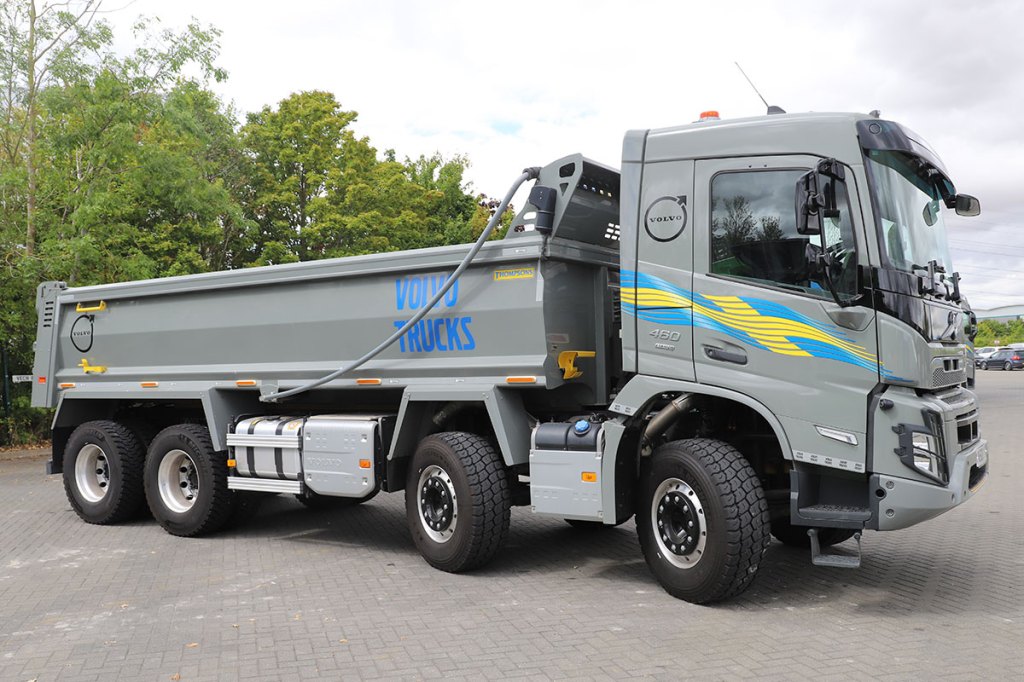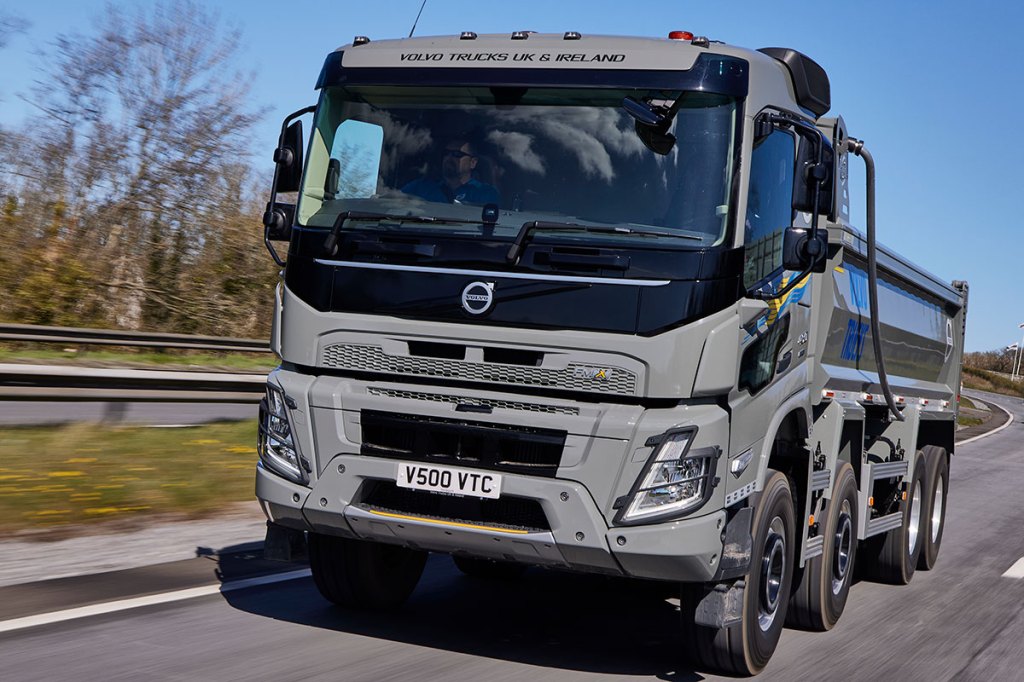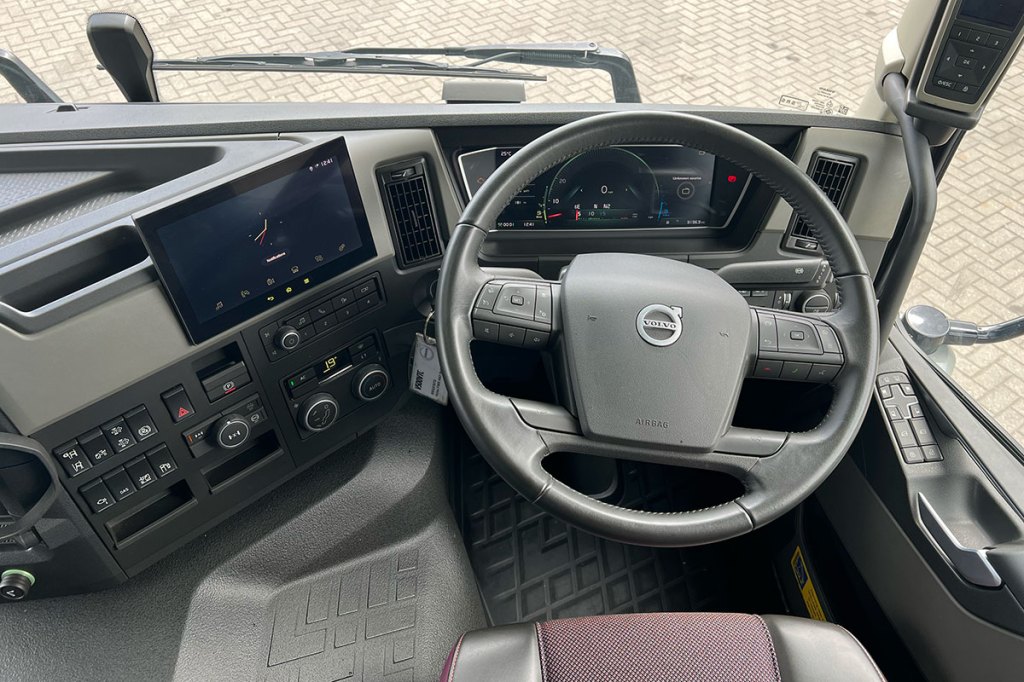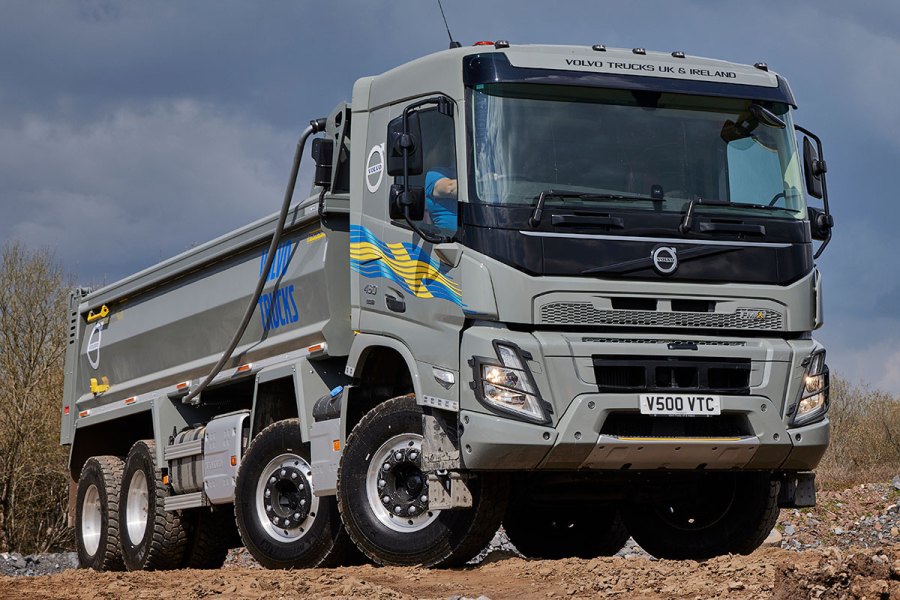Volvo’s FMX range was launched in 2010 as a heavy-duty version of its popular FM platform, intended for the tougher off-road jobs, such as quarries, forestry and construction work. Like the FM, it had a completely new cab a few years ago.
The 8×4 chassis was a peculiarly British set up for many years, and it remains so. No longer exclusive to us Brits, of course, but while eight-wheelers for general haulage are certainly rare these days, 8×4 tippers remain a big part of the UK truck fleet.
While manufacturers have, for a long time, had different chassis thicknesses for different markets, in recent years there has been a trend to differentiate between a ‘general’ haulage and road chassis and a thicker, so sturdier, chassis for those jobs which take the truck off the tarmac of sizeable distances. That can be into quarries, onto construction sites, into the forest to collect timber or into farms.
These chassis are not just restricted to 8x4s, and in fact, most manufacturers will offer them for just about any configuration you like – rigid or tractor. Volvo started the trend with its FMX which was launched in 2010. Mercedes introduced its Arocs in 2012 and Scania followed in 2017 with its XT range – both of which could be seen on every cab and axle set up the companies offered. Renault has its Range C and K models. Next will be DAF’s XDC and XFC models while Iveco has its X-Way and Trakker models. MAN offers tougher chassis, but doesn’t differentiate other than on the badge designations. Maybe it should introduce a SuperMAN range?!!
The subject of this Driven piece is Volvo’s relatively new FMX460 in its most common form – an 8×4 tipper. These are popular with landfill, demolition contractors, quarry work and other construction applications. The main trade-off for a tougher chassis is slightly less payload and a higher ground clearance – which is advantageous for the terrain the trucks cover, but more of a challenge for the driver to get in and out.
So when I was offered the chance to drive an FMX460 8×4, I jumped at the chance. It wasn’t the first time I’ve driven an FMX with the new cab, but that had been the briefest of drives and it was a couple of years ago, so I was keen to get behind the wheel and see how it performed on a longer drive.

Technical overview
Like the FM range, the FMX can be specified with either the 10.8- and 12.8-litre Volvo straight six engines be it a 4×2, 6×2, 6×4, 8×2 or 8×4 and all those axle arrangements are available with the FMX chassis, as well as a few other special orders such as 4×4, 6×6, 8×6 and 8×8 – very few of which are likely to appear on our shores. It is also possible to order FMXs as tractor units, and 6x4s are suitable for heavy haulage or landfill work while a 6×2 tag axle is a decent tool for forestry work.
But the truck I drove was the type of FMX you are most likely to see, an 8×4 tipper aimed at muckaway, quarry, construction and other work where there is plenty of road driving, probably still a majority – but they tend to go off road for collection or deliveries. Hence having a thicker chassis can be beneficial and because the chassis is thicker there is naturally a little bit more metal in them which makes them heavier.
My truck had the 460hp version of the popular 12.8-litre straight six; that delivers 460hp at 1,400-1,800rpm and 2,300Nm of torque at 900-1,400rpm. It is the second of four outputs from this engine; 420, 500 and 540hp being the others – with 2,100, 2,500 and 2,600Nm of torque. The six-cylinder engine is, of course, Euro 6, but it is Step D and not the slightly newer Step E.
If you opt for the smaller engine, you’ll save a good few kilos of weight, but for FMXs the chances are that isn’t your key priority. Nevertheless the smaller engine can be specified at ratings of 330, 380, 430 and 460hp so there is an overlap at the top two ratings. The torque ratings for this engine are 1,600, 1,800, 2,050 and 2,200Nm, so by spec’ing the bigger engine you get that useful extra 100Nm of torque if you want 460hp.
The bigger engine is also a little less stressed and delivers comparable, if not slightly better, fuel consumption figures than its smaller sibling. Again though, fuel consumption, which obviously important, isn’t necessarily the biggest driving factor in vehicle specification and acquisition in this sector.
But overall between the two engines and their eight outputs, it gives Volvo an incredibly varied range of power and torque ratings from 330-540hp and 1,600-2,600Nm so there really is something to suit all operators and uses. That said, 460hp is probably the most popular, though more and more eight-wheeler operators are edging up to 500hp and as such the 330/370hp engines are really only best suited for a 4×2 or 6×4. The 540hp top output is every useful for those hauliers going off road and up hills at the same time. You can’t have Volvo’s turbo compound option on an FM or FMX.
The gearbox is Volvo’s ever-popular I-shift AT2612F 12-speed automatic, a responsive, effective, easy-to-use gearbox with few critics. The Dual Clutch is an options, but not one that currently has an especially wide take up form operators.
Some drivers still hanker after a manual box for off-road operations, though I can’t see the attraction at all in this case. If I’m driving off road, up a forestry track, I’d like to keep my hands on the wheel all the time rather than having to change gear and also the risk of inadvertently selecting the wrong gear can be ‘problematic’ in certain situations!
The truck I had was on a 5,100mm wheelbase was fitted with a Thompson steel tipper body. Other wheelbase options are 5,600, 6,000 and 6,400mm although the latter two are never specified for tippers, and only used for timber and a few other specialist operations. In fact, Volvo says 99% of the tippers will be on the same wheelbase as this test truck.
The chassis was also the extra high option which means the truck has an impressive off-ground clearance, which is what is what you need for this kind of tipper. That means it is more of a challenge to get into the cab but it has three step entry, with the bottom step being flexible to avoid the risk of damage.
Being the shortest of those wheelbases, the kerbweight of the chassis-cab was 9,445kg, giving a 22,555kg allowance for driver, fuel, body and payload. The tare weight was 12,860kg so a 19,140kg payload was possible which is very good for the specification.
My truck had a day cab – sleepers and Globetrotter high-roofs variants are options, which obviously add a bit of extra weight but do help residuals and are often preferred by drivers as they give them more room. Overnighting in this kind of truck is increasing as companies in construction often now bid for contracts away from their home patch and that can see their drivers away for several nights in the week, in which case they’ll really need a Globetrotter.
Understandably, 8x4s are never the easiest things to turn round, but the turning circle diameter, wall to wall, is 22.1m. All wheels were Alcoa brushed aluminium – which look great and save weight – and the drive axles had 315/80 R22.5 Michelin X Works tyres while the steer axles both had 385/65 R22.5 Michelin XZY3s. The front axles both had 8,000kg capacity and the rear bogie was 21,000kg. Front axles can be 9,000 or 10,000kg if necessary – highly unlikely these would be required in the UK, and the same applies to the 23,000 or 26,000kg rear bogie options – you’d need these for internal use work only where the truck will go way above its 32 tonnes legal GVW and not head onto public roads when full to capacity.
The new cab is the most noticeable feature and is based on the new Version 5 FM cab, which was launched in 2020 to replace the FM cab introduced in 1998 and on FMX models since 2010. It had the headlight protectors and a steel bumper; features you need when running off-road. Volvo still uses conventional mirrors.
Inside the cab is the new Volvo digital display set up which comprised a standard style dash set up – in other words the display is enclosed and looks ‘part’ of the truck and not an afterthought ‘add-on’. There is a tablet-style screen to the driver’s left for the infotainment system.
The dash can be set up as one of four different screen options, so it’s a case of finding the one that best works for you. Of course you can change it but drivers tend to find the one they prefer and stick with it. The new dash is a vast improvement. It’s bright, clear and informative and the resolution is excellent and easy to use. Interestingly, of all the ‘new gadgets’ being introduced on trucks, I’ve not heard anyone moan about a digital display! It is hard to fault it.
The new FM/FMX cab is superb, and I’m a huge fan of it. It’s well laid out, well set up for the driver, very comfortable and very roomy. Volvo has put the driver at the forefront of everything it has done to redesign the cab interior.
Even as a day cab, there’s plenty of room. More tippers like this are now being specced with day cabs, though it’s probably fair to say the FM is more likely to be a sleeper than the FMX. But there is enough space for your bag, hard hat, hi-viz coat and other day-to-day equipment. The cab is well-appointed and that makes it’s a nice place for a day’s work. The fixtures and fittings are also durable, and the part-leather seats are easy to clean.

On the road
While hauliers do not usually use tippers for multi-drop work as such, they are often used for short distance, repeat loads. So while it’s a bit of a climb to get in the cab, the chances are you won’t be in and out of it all day, and given my test truck had an automatic tailgate, the driver wouldn’t necessarily have to get out to tip the load.
That said, drivers may still have to get out to get paperwork signed or collected, so while it’s a pain to a degree, a high ground clearance is a prerequisite for this work and it’s just a price you have to pay. So yes, it’s a bit of a climb to get into the cab, especially if carrying a bag or a flask, but you just have to take care. Tipper drivers will soon get used to it, and they get the added bonus of a mini-workout every time they do get on board!
The passenger door had a lower window to see cyclists, although how much use it is, given how high the truck sits, is open to debate. Many drivers question why these windows are necessary and, in this case, I would really wonder what advantages it gives; I would assume any cyclist’s head is going to be below the bottom of the window – the kerbside mirror is your tool to see anyone stupid enough to come up alongside your truck.
My FMX was loaded with 19 tonnes of gravel, but sadly I wasn’t able to take it off road, but what I can say is the driving experience was very pleasurable and comfortable indeed.
As is now par for the course, the truck has plenty of useful buttons on the steering wheel, such as the cruise control and the ability to answer your phone hands-free which make it much safer to drive yet still gives you control over both the vehicle and the job in hand. On the door panel are the buttons for the mirrors and windows.
The three-stage engine brake is on a stalk on the right, which is easy to use, and it’s also very effective. It holds the truck exceptionally well when going downhill, and fully loaded must be a very useful tool for drivers – those in quarries and forests will especially appreciate this feature.
As I say, the route was all on road, with a spell of town, village and dual-carriageway driving, with several hills – both climbs and descents – and it handled superbly and pulled without any issue whatsoever given the decent power and torque on tap. The spec was just right.

Conclusions
As I have come to expect from Volvos these days, the driving experience is always pleasurable and the new FMX cab is a lovely place and one of the best in its class.
There’s not a lot to fault the truck on, with a good body on it, you’ll get close to just over 19 tonnes of aggregates on board. The 12.8-litre has a proven track record of delivering superb fuel economy – not always the most pressing factor for hauliers in this sector, but a consideration that is certainly no bad thing!
Volvo has a strong tradition in the eight-wheeler market and they have proved popular with tipper men. The FMX builds on that tradition, and the new models with the new cab are, as you’d expect, even better. If you are looking to acquire a new tough, versatile and economic truck in this sector, you’d been a fool not to run the rule over the FMX. As with most Volvos, the business case remains very strong and the cost of owning its trucks are incredibly favourable.
Also, the longevity of Volvos is superb and even for a truck like an FMX that will potentially take a hammering during its working life off-road, assuming you look after it, then it will last you a long time. Residuals are also very good.
By the time you read this, I’ll have had my first drive of what could be the biggest competitor to the FMX – DAF’s new XDC/XFC trucks – but these Dutchmen will have a big challenge on their hands to match the FMX. In the meantime, if you are in the market for a tough chassis, eight legger, then the FMX simply has to be looked at in detail.
We like
- The new cab
- Good payload
- Wide range of options
- Comfortable drive
We don’t like
- Often wondered why there isn’t an FHX!
Specifications
Volvo FMX460
- Design GVW: 32 tonnes
- Chassis: 5,100mm wheelbase
- Front axles: 8,000kg
- Rear axle: 10,500kg
- Gearbox: AT2612F 12-speed automatic
- Engine: D13K 460 12.8-litre straight six
- Max power: 460 hp @ 1,400-1,800rpm
- Max torque: 2,300Nm @ 900-1,400rpm
- Cab: FM day







